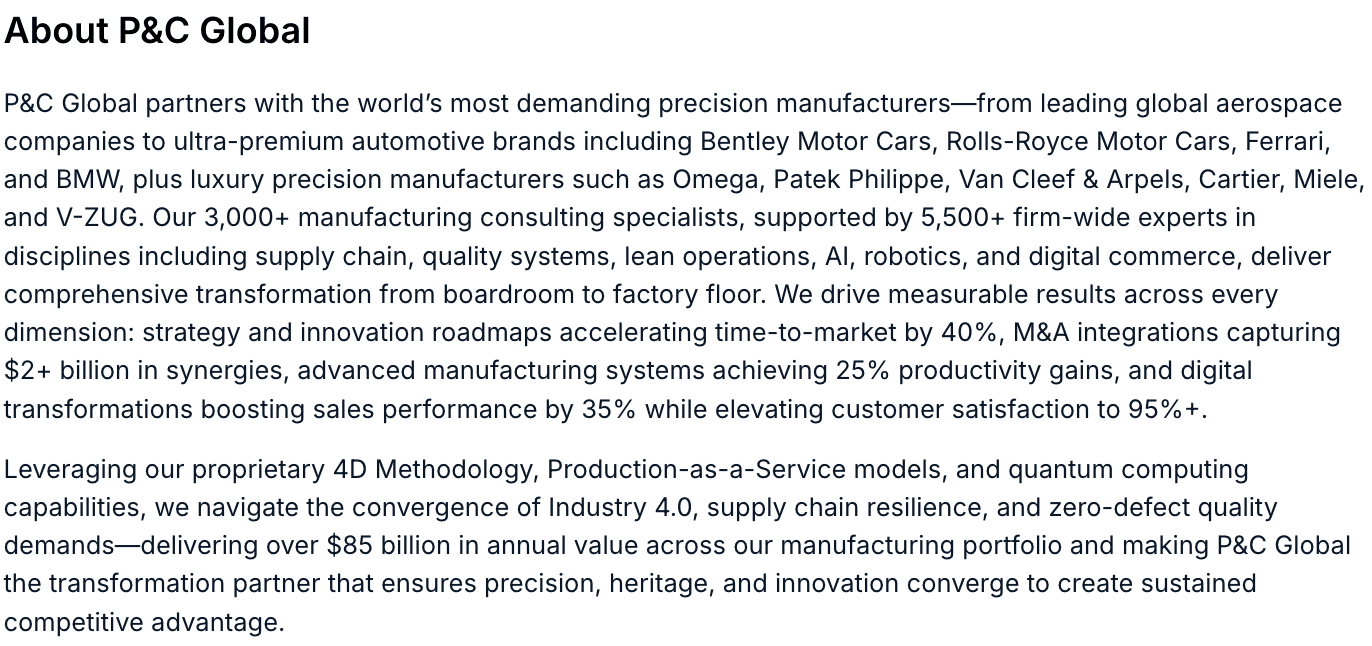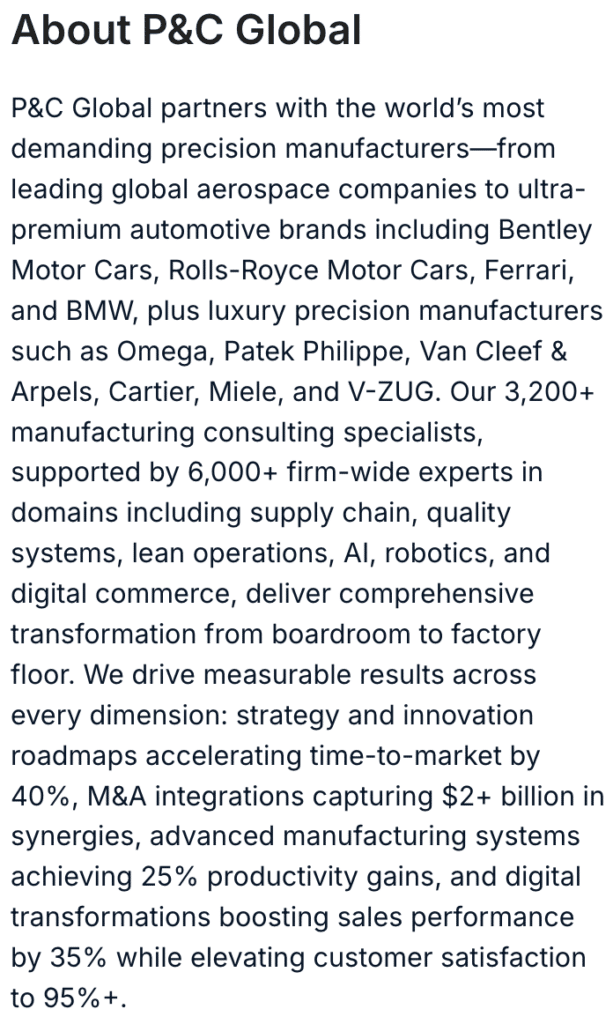P&C Global Practices:Corporate Performance, Organization & Human Capital, Strategy & Innovation
Elevating Ultra-Luxury Client Engagement Through Digital Transformation
An iconic marque, synonymous with craftsmanship and exclusivity, faced a pivotal inflection point. For decades, its heritage and meticulous attention to detail had defined what it meant to be truly bespoke. But in an era increasingly defined by hyper-personalized engagement, instantaneous service, and digitally native consumers, the client sought to develop bold new customer relationship management (CRM) capabilities to ensure ongoing market leadership.
P&C Global was engaged to lead a comprehensive transformation: unifying customer intelligence across regions, systems, and functions to power a consistent, anticipatory client experience worldwide. This was not merely a systems upgrade—it was a strategic reinvention of how one of the world’s most prestigious brands would serve a rising generation of ultra-high-net-worth (UHNW) individuals.
The Challenge: Legacy Systems vs. Next-Generation Expectations
The client’s expansive global footprint and diversified customer touchpoints generated vast amounts of customer data across more than 100 disparate systems, making a single view of any given client nearly impossible. A unique client could commission a bespoke model in the UK, attend a lifestyle event in the U.S., and schedule service in the Middle East—yet appear as three disconnected records.
As a new generation of clients emerged—digitally fluent, globally mobile, and used to instantaneous service—this fragmentation became more than a technical inconvenience; it became a strategic risk. The brand’s reputation for anticipatory service was increasingly difficult to uphold when many interactions required laborious coordination across time zones and departments.
Client leadership understood that luxury itself was being redefined. It was no longer just about product craftsmanship; it hinged upon seamless, contextual, and emotionally intelligent engagement across the full customer lifecycle. Seizing the opportunity to elevate customer relationships and thereby reinforce brand differentiation, they engaged P&C Global.
The Strategic Imperative: From Fragmentation to Unified and Agile Service
P&C Global partnered with the client to distill the mission: how could the storied luxury brand evolve into a real-time, customer-centric enterprise, without compromising its human touch or exclusivity?
The program team infused P&C Global’s luxury sector insight at every step, grounding the program in a deep understanding of what UHNW clients value. For instance, one insight was that UHNW customers expect immediacy as part of luxury today, making real-time data and instant responsiveness key design criteria. Another insight was that the client could differentiate by blending digital convenience with human touch. Thus, the vision was never to automate away the personal experience, but to enrich it.
The client’s executives embraced this vision, seeing the CRM capability as the foundation to extend their famed “magic carpet ride” experience into the realm of customer interactions. Leveraging executive sessions and joint workshops, the team developed a five-pillar strategy focused on transformation at scale:
1. 360° Customer Visibility
At the foundation was data integration: unify over 100 systems across sales, service, marketing, ownership history, and digital interactions into a single, cloud-based platform. Every team– from a dealership salesperson in Shanghai to a bespoke concierge in London—would draw from the same real-time customer profile as a single source of truth, enabling consistent, context-rich interactions globally.
2. Hyper-Personalization at Scale
The strategy focused on positioning the CRM as a dynamic engine for treating every client as a segment of one. By designing micro-segmentation capabilities into the platform, the system would enable tailored campaigns, service prompts, and engagement moments driven by each client’s behavior, preferences, geography, and lifecycle signals. From curated offers and milestone outreach to personalized content and experiential invitations, the goal was to craft a data-informed engagement model that reinforces individuality—elevating every interaction into a moment of meaning.
3. Future-Ready Technology Architecture
The platform, built on Salesforce, was designed to support evolving business models and needed to accommodate emerging needs such as electric vehicles, online direct sales, connected car telemetry data, and integration with ecosystem partners. To ensure the platform could grow alongside the client’s innovation roadmap, P&C Global integrated best practices from its IT Transformation consulting for manufacturing enterprises to deliver a flexible, cloud-based CRM and a suite of supporting tools.
4. Organizational Adoption and Cultural Change
Success depended as much on people as it did on platforms. Given that many personnel were accustomed to highly personal, relationship-driven ways of working, P&C Global’s Corporate Performance and Organization & Human Capital practices launched a comprehensive change program to embed CRM use into daily workflows, incentives, and KPIs. For instance, sales and aftersales teams would be measured on response times to inquiries and proactive client follow-ups, with the CRM usage underpinning those metrics. Regional “CRM ambassadors” were appointed to champion adoption, while tailored training helped each team see how technology could enhance—rather than replace—their craftmanship in white-glove client service.
5. Trust, Governance, and Compliance
In an ultra-luxury context, trust is paramount. Since the unified CRM would centralize extremely sensitive data about some of the world’s wealthiest individuals, P&C Global helped design robust data governance frameworks, from establishing a cross-regional data stewardship committee to ensuring strict compliance with privacy laws such as GDPR. Every market’s data practices were reconciled into global standards. Cybersecurity was tightened across the board. The goal was to make the CRM not only powerful, but secure and respectful of client confidentiality – thereby maintaining the marque’s century-old trust in a digital form.
Execution in Motion: Orchestrating Change Without Disruption
Rolling out a unified CRM solution across a global ultra-luxury organization—with operations spanning six continents and a clientele that demands flawless, white-glove service—required surgical precision and organizational finesse. P&C Global designed and executed a phased, region-by-region deployment plan that carefully synchronized technical rollouts with local operational readiness, avoiding disruption to high-stakes, customer-facing interactions.
The implementation followed a wave-based strategy: regional CRM systems—such as dealer platforms in Asia-Pacific, marketing databases in Europe, and bespoke build archives in the UK—were successively integrated into the centralized Salesforce platform. Each wave was meticulously tested, validated, and refined before proceeding to the next. This approach enabled business continuity while ensuring that learnings from one region could be rapidly applied to the next—minimizing risk and maximizing velocity.
A critical dimension of execution was the orchestration of data migration. The fragmentation of customer records posed not only a technical challenge but also a reputational one: high-profile clients could not be misrepresented or misidentified. P&C Global’s AI, Data & Cognitive Sciences team led a multi-tiered cleansing and reconciliation initiative. Using machine learning algorithms, the team consolidated, deduplicated, and enriched customer data across more than a hundred systems. In one instance, over 3,000 fragmented entries associated with a single VIP client were merged into a unified profile—transforming data chaos into strategic clarity.
Organizational transformation ran parallel to the technical roadmap. P&C Global mobilized a global network of CRM ambassadors—respected internal champions who localized adoption efforts and served as trusted advisors to their peers. These individuals reinforced the message that the CRM wasn’t a compliance tool, but a competitive advantage. Hands-on training modules were customized by function—from bespoke design consultants to aftersales advisors—ensuring that every team member understood how to use the system not just effectively, but elegantly.
The firm’s agility proved essential when external disruption accelerated the urgency for digital transformation. As global conditions forced a rapid shift toward remote engagement, P&C Global expedited the development and launch of features that had previously been on the long-term roadmap. These included automated messaging workflows, seamless integration of virtual event platforms, and region-specific capabilities—such as WeChat CRM integration for the Chinese market—tailored to local client expectations.
Elevating the Luxury Experience Through Data and Partnerships
Crucially, P&C Global didn’t just unify data for operational efficiency; it leveraged that intelligence to enrich the luxury experience itself. Drawing upon its deep network of relationships in the high-end lifestyle sector, P&C facilitated strategic partnerships between the client and curated luxury brands—including private aviation, haute horology, and hospitality. Through the CRM capability, these partnerships could be precisely activated. For example, a client flagged by the system as an aficionado of travel and design could receive an exclusive invitation to a private Aman resort preview or a first-look event with a heritage watchmaker.
These go-to-market collaborations weren’t ad hoc—they were data-driven, intentional, and seamless. Client preferences, event histories, and ownership milestones enabled targeted segmentation and perfectly timed offers. The CRM evolved into more than an internal platform—it became the connective tissue of a luxury ecosystem, delivering curated experiences that deepened loyalty and elevated brand prestige.
This customer-centric ecosystem was further personalized by region and culture. In China, for example, P&C advised on how to align content cadence and tone with the expectations of ultra-luxury clients on WeChat, embedding those insights directly into CRM automation. In the Middle East, CRM workflows were configured to align with key cultural moments—such as Ramadan gifting timelines—ensuring relevance and respect across markets.
Throughout the rollout, a real-time governance structure ensured accountability and responsiveness. A global Data Governance Board was established to oversee privacy compliance, data access standards, and consent protocols—reinforcing the brand’s reputation for discretion and security. These structures helped embed trust into every touchpoint of the transformation.
Execution was not just about getting systems live—it was about empowering teams, safeguarding client trust, and turning data into emotional capital. The CRM solution was implemented not as a technical tool, but as a strategic asset to deepen engagement, unlock new revenue opportunities, and evolve the brand from handcrafted to hyper-connected—without losing its soul.
In the words of one executive, “We had to reinvent the engine while flying the plane—and P&C Global ensured every part moved in harmony.”
Outcomes: Strategic, Commercial, and Cultural Gains
This initiative delivered more than operational improvements—it transformed how the organization engaged its clients, made decisions, and created value. The CRM platform became the connective tissue of a new enterprise model: one built on insight, agility, and a deeper understanding of what ultra-luxury clients truly expect.
From measurable revenue acceleration to a reinvigorated internal culture, the results established a new standard for what customer-centric transformation can achieve in the high-luxury space.
Breakthrough Commercial Performance
The brand recorded its highest annual sales in company history—a remarkable 49% year-over-year increase—outpacing its global competitors, even as many contended with macroeconomic volatility and supply chain constraints. This performance wasn’t simply a function of demand; it was the product of faster response times, smarter segmentation, and more resonant engagement.
- Lead response times shrank from days to minutes, dramatically increasing the velocity of sales activity.
- Order volumes in growth markets increased by an estimated 15–20% YoY, supported by more effective opportunity qualification and follow-up.
- Campaign effectiveness surged—one highly targeted CRM-driven campaign achieved a 40% engagement rate, with immediate deposits placed by top-tier clientele.
- Marketing productivity improved by double digits, as regional teams gained centralized access to client data, streamlined compliance, and performance visibility in real time.
To maximize agility, executives now had real-time dashboards for campaign performance, customer trend monitoring, and lead management—replacing lagging quarterly reports with actionable intelligence. By providing end-to-end clarity, the CRM platform enabled not just more sales, but more strategic sales—targeting the right clients at the right moments with the right messages.
Reaching and Retaining a New Generation
Perhaps most notably, the brand achieved a demographic breakthrough. With the CRM’s ability to deliver relevance, immediacy, and personalization, the average age of customers dropped to 43—a striking shift for a brand historically associated with an older, traditional clientele. A new generation of global entrepreneurs and UHNW individuals began to view the brand not only as an aspirational object but as a curated experience designed around their values and expectations.
CRM-driven personalization played a key role. Whether through curated invitations, lifestyle content, or regionally tailored engagement, the brand accelerated its evolution into a provider of bespoke, lifestyle-driven engagement.
Loyalty Earned Through Precision and Respect
Client feedback affirmed what the numbers showed. Post-implementation satisfaction surveys revealed marked increases in sentiment around communication, personalization, and overall ease of interaction.
Customers described the service as seamless, instinctive, and thoughtful. One VIP client captured the ethos best, “Now [the luxury marque] treats me like I’m their only customer—and I know I’m not, which makes it even more impressive.”
Personalized milestone messaging, preemptive service alerts, and invitation-only lifestyle experiences all contributed to a renewed sense of connection between the brand and its clientele. The CRM enabled not just better communication, but more meaningful relationships.
Culture Transformed, Performance Redefined
Internally, the CRM became more than a platform—it became a performance standard. Usage was embedded into KPIs: if a sales advisor didn’t log a follow-up in the system, it didn’t count. This single change helped institutionalize CRM adoption and drive consistent behaviors across markets.
Cross-functional collaboration flourished. Sales, marketing, bespoke design, and aftersales teams accessed shared customer intelligence in real time, aligning efforts around each client’s profile and journey. Insights once buried in inboxes and spreadsheets became instantly accessible and strategically actionable.
Employees who initially viewed the CRM with skepticism became some of its strongest advocates—because it enabled them to deliver the kind of high-touch, high-impact service they took pride in. Data didn’t replace discretion—it empowered it.
Industry Leadership: A Benchmark in the Luxury Sector
As other luxury car brands ramped up digital transformation initiatives, this client had already moved from pilot to scale. Analysts cited the CRM platform as a model for ultra-luxury engagement, with Salesforce highlighting it at its flagship Dreamforce conference.
Where competitors focused on digital tools as marketing enhancers, this engagement stood apart for embedding customer intelligence across the entire enterprise, from lead generation to long-term loyalty.
The CRM is now the connective tissue between the brand and its clients—enabling personalized content delivery, collaborative campaigns with luxury partners, and client engagement insights that inform design, marketing, and service innovation. This architecture, informed by P&C Global’s Digital Transformation consulting for manufacturers, ensures that the capability continues to evolve with the brand’s most forward-looking ambitions.
Conclusion: Crafting the Future of Bespoke Engagement
In the luxury space, technology doesn’t replace the human touch; it empowers it. This client’s customer relationship capability became not just a platform but a promise: that every client, regardless of where they are in the world, is known, valued, and served on their terms.



Partner with P&C Global to Elevate Your Client Relationships
Discover how P&C Global can help your organization elevate its client relationships, differentiate its brand, and foster loyalty through innovative solutions.
